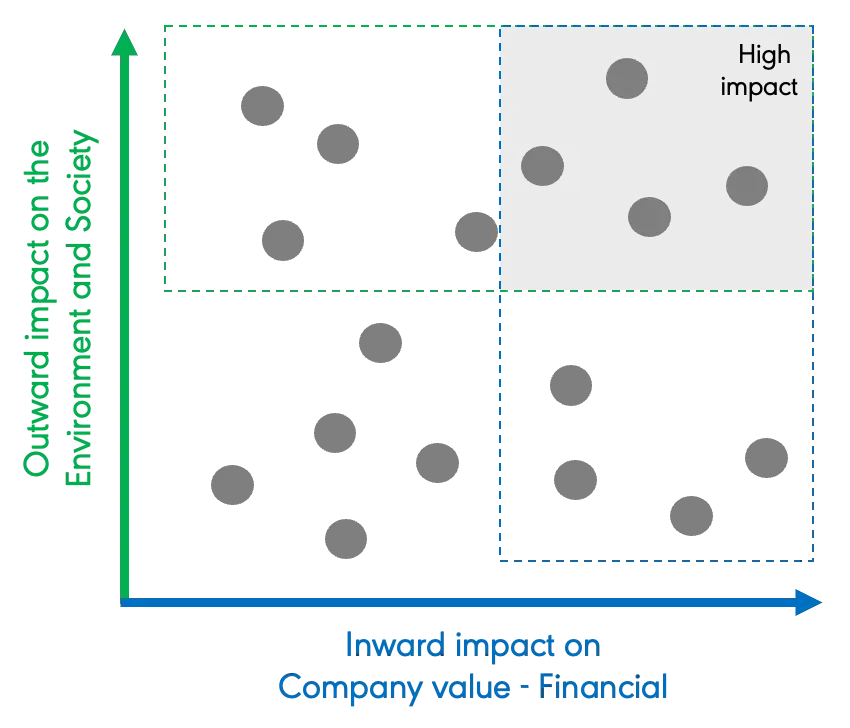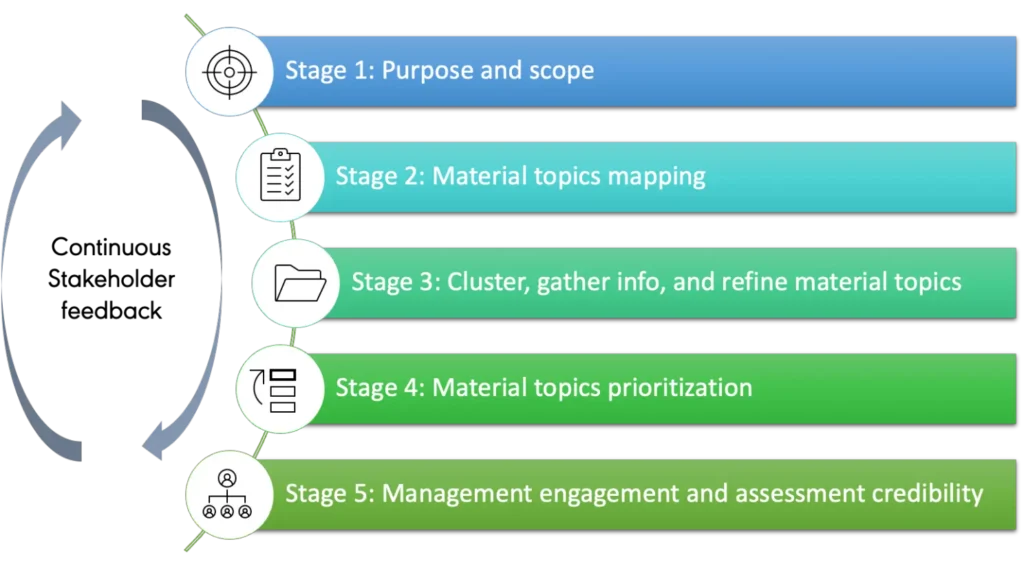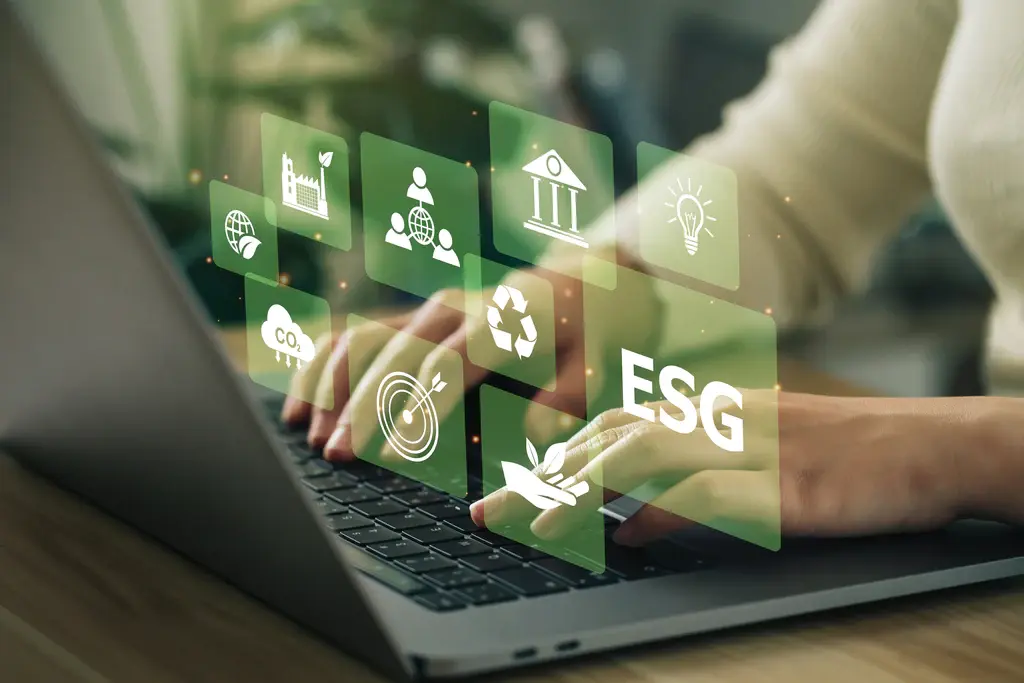In general, corporations define materiality as the information stakeholders, investors, and leaders need to assess meaningful effects on the value of a company and its strategy before making strategic decisions [1].
Regarding sustainability/ESG, materiality assessment is the process of defining, refining and appraising critical social and environmental issues relevant to a business’s operating context, which should directly influence its sustainable innovation strategy [2]. For example, in consumer goods, materiality assessment should include how sustainability topics affect their products and consumers, which are the core of any innovation strategy.
Over the past years, companies have primarily used materiality assessments as a communications and reporting exercise. However, a holistic materiality assessment can be a powerful tool to generate insights, enabling the identification and prioritization of crucial ESG topics that leaders must use to shape an effective, sustainable innovation strategy.
Employing a materiality process and a sustainability lens to trend-finding and map opportunities for business continuity and growth can revamp any innovation strategy. Previous research has shown that companies that have innovation at the core of their strategies are about 5 times more likely to excel in sustainability [3]. The benefits of a holistic materiality process for sustainable innovation are highlighted as:
- Trend identification for effective, sustainable innovation strategy building, such as upcoming freshwater shortfall and biodiversity loss, directly affecting product development and consumer resources usage.
- Cross-functional readiness for new product and business model development for competitive advantage.
- Resources prioritization for targeted activities that enable the highest impact.
- Embedment of the sustainable innovation strategy in the broader corporate processes and targets.
When the materiality assessment is carried out focusing on aspects that lead to the financial performance of a company or strategy, i.e., inward impact, that is called financial materiality, conversely, when the analysis involves systemic issues influencing social and environmental topics and their impact on people and the planet, i.e., outward impact, that is typically referred to as impact materiality.
The Sustainability Accounting Standards Board (SASB), part of the IFRS Foundation, is known for its practical standards to appraise financial materiality for different industries and provide sustainability-related risks and opportunities [4]. Similarly, the Global Reporting Initiative (GRI) is well-established to evaluate impact materiality, offering standards to track and report environmental, social, and economic activities [5].
A sustainable innovation strategy certainly benefits from a holistic view of sustainability performance, which ideally combines both approaches through a double materiality assessment as shown in the following graph [6].

This combined analysis clearly brings to light how different sustainability topics may impact the planet and the enterprise value, thus, helping to select critical interfaces for a successful sustainable innovation strategy. The assessment process can typically be summarized in 5 essential stages encompassing both financial and sustainable impact topics. An integrated approach comprising the ability to engage with all stakeholders and consider social-ecological contextual factors is proven to be more effective.
- Stage 1: Purpose and scope.The first recommended stage is getting clarity on the purpose of the assessment and how financial and sustainable impact aspects can benefit the innovation strategy. From that, the team can scope material topics by defining critical regions and parts of the business that will be covered, mapping out boundaries of material issues across the value chain, and deciding how the process would be reported and monitored.
- Stage 2: Material topics mapping.Research and list relevant potential material topics by reviewing internal and external sustainability reports and engaging with critical stakeholders. This step is also the right time to involve key people outside the sustainable innovation team, such as senior leadership, risk management, legal, R&D, supply, and others, to assign their roles and responsibilities.
- Stage 3: Cluster, gather info, and refine material topics.Organizing material topics into categories brings value to building a sustainable innovation strategy. Analyze each material topic considering their respective stakeholders to thoroughly comprehend its importance to the sustainable innovation strategy. In this phase, leaders should agree on the methodology to measure and monitor each topic to define assessment units and check how granular issues can be in different clusters, e.g., social vs environmental analysis. When it comes to sustainable innovation strategy, it is particularly relevant to connect each material topic to external trends such as product developments, novel technologies, and consumer behavior.
- Stage 4: Material topics prioritization. This phase ranks and prioritizes the material topics based on their strategic importance to the innovation portfolio, their contribution to the business, and their overall impact on different parts of the value chain.
- Stage 5: Management engagement and assessment credibility.Senior sustainability and innovation leadership should approve materiality assessment results, ensuring that the process and its outcomes are credible to be fed into the broader corporate sustainability strategy.

With constant stakeholder feedback throughout each phase, leaders can promptly consider any missing piece of the systemic approach. Continuous feedback in each stage is critical to increase the probability of success and confidence levels before repeating the process.
Many innovation teams carry out materiality assessments commonly driven by the reporting of metrics. While this is also important, the high value of a holistic materiality assessment comes from understanding insights and embedding them into a future-facing sustainable innovation strategy. This insight-inclusive approach is referred to as a strategic materiality approach, which utilizes financial and impact metrics for reporting.
“Innovation teams that adopt the strategic materiality approach boost their future readiness by strengthening their sustainable innovation strategy.”
To develop a sustainable innovation roadmap and strategy, innovation teams should use the comprehensive data generated through a strategic materiality assessment, including sustainability trends, market shifts, and regulatory landscape. These insights can help map out risks, ensure proposals of new products and services considering sustainability topics aligned to business objectives, and identify new markets and models applying sustainability as a business driver.
Innovation teams that adopt the strategic materiality approach boost their future readiness by strengthening their sustainable innovation strategy. Identifying emerging trends and issues such as consumer behavioral changes, biodiversity consciousness, and water availability can propel more business impact and resilience. An innovation mindset applied to a strategic materiality approach is critical to stress test results of the analysis against future-facing scenarios, enabling the company to be ahead of the curve and be more competitive.
References
[1] McClure, C. and Arias, D., “The benefits of an ESG materiality assessment”, Forbes (2022).
[2] KPMG, “The KPMG Survey of Corporate Responsibility Reporting” (2013).
[3] Makower, J. “Two steps forward: How sustainability drives innovation.” GreenBiz (2013).
[4] IFRS Foundation. “SASB Standards overview” (2023).
[5] GRI Standards, “Get started with reporting” (2023).
[6] Harrison, D. and Banchilhon C., “Why Companies Should Assess Double Materiality” BSR report (2021).











